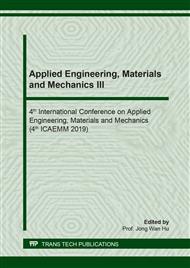[1]
M. Sahooli, S. Sabbaghi, R. Saboori, Synthesis and characterization of mono sized CuO nanoparticles, Mater. Lett. 81 (2012) 169-172.
DOI: 10.1016/j.matlet.2012.04.148
Google Scholar
[2]
K. S. Khashan, G. M. Sulaiman, F. A. Abdulameer, Synthesis and Antibacterial Activity of CuO Nanoparticles Suspension Induced by Laser Ablation in Liquid, Arab. J. Sci. Eng. 41(1) (2016) 301-310.
DOI: 10.1007/s13369-015-1733-7
Google Scholar
[3]
D. K. Pritchard, Literature review, Health and Safety Laboratory, (2004).
Google Scholar
[4]
T. Berger, J. Schuh, M. Sterrer, O. Diwald, E. Knözinger, Lithium ion induced surface reactivity changes on MgO nanoparticles, J. Catal. 247(1) (2007) 61-67.
DOI: 10.1016/j.jcat.2007.01.008
Google Scholar
[5]
R. Katwal, H. Kaur, G. Sharma, M. Naushad, D. Pathania, Electrochemical synthesized copper oxide nanoparticles for enhanced photocatalytic and antimicrobial activity, J. Ind. Eng. Chem. 31 (2015) 173-184.
DOI: 10.1016/j.jiec.2015.06.021
Google Scholar
[6]
S. M. Tawfik, A. Saleh, A. Elbeih, T. M. Klapötke, Reactive nanocomposites as versatile additives for composite propellants, Zeitschrift fur Anorganische und Allgemeine Chemie. 642(21) (2016) 1222-1229.
DOI: 10.1002/zaac.201600285
Google Scholar
[7]
A. Tiwari, Y. K. Mishra, H. Kobayashi, A. P. Turner, Intelligent nanomaterials, John Wiley & Sons, (2016).
Google Scholar
[8]
P. W. M. Jacobs, H. Whitehead, Decomposition and combustion of ammonium perchlorate, Chem. Rev. 69(4) (1969) 551-590.
DOI: 10.1021/cr60260a005
Google Scholar
[9]
I. Boshra, A. Elbeih, H. E. Mostafa, Improving the mechanical properties of glycidyl azide polymeric matrix used in composite solid rocket propellant by adding advanced cross-linker, Zeitschrift fur Anorganische und Allgemeine Chemie.
DOI: 10.1002/zaac.201900003
Google Scholar
[10]
M. Abd-Elghany, A. Elbeih, S. Hassanein, Thermal behavior and decomposition kinetics of RDX and RDX/HTPB composition using various techniques and methods, Cent. Eur. J. Energetic Mater. 13(3) (2016) 714-735.
DOI: 10.22211/cejem/64954
Google Scholar
[11]
Z. Ma, F. Li, H. Bai, Effect of Fe2O3 in Fe2O3/AP composite particles on thermal decomposition of AP and on burning rate of the composite propellant, Propellants, Explosives, Pyrotechnics, 31(6) (2006) 447-451.
DOI: 10.1002/prep.200600060
Google Scholar
[12]
L. Li, X. Sun, X. Qiu, J. Xu, G. Li, Inorganic chemistry. 47(19) (2008) 8839-8846.
Google Scholar
[13]
R. Damse, A. Sikder, Role of inorganic additives on the ballistic performance of gun propellant formulations, J. hazard. mater. 154(1-3) (2008) 888-892.
DOI: 10.1016/j.jhazmat.2007.10.103
Google Scholar
[14]
G. Duan, X. Yang, J. Chen, G. Huang, L. Lu, and X. Wang, The catalytic effect of nanosized MgO on the decomposition of ammonium perchlorate, Powder technol. 172(1) (2007) 27-29.
DOI: 10.1016/j.powtec.2006.10.038
Google Scholar
[15]
S. Zeman, S. Q.-L. Yan, A. Elbeih, Recent advances in the study of the initiation of energetic materials using the characteristics of their thermal decomposition Part II. Using Simple Differential Thermal Analysis, Cent. Eur. J. Energetic Mater. 11(3) (2014) 395-404.
DOI: 10.1016/b978-0-444-64062-8.00006-1
Google Scholar
[16]
A. Elbeih, M. Abd-Elghany, T. Elshenawy, Application of vacuum stability test to determine thermal decomposition kinetics of nitramines bonded by polyurethane matrix, Acta Astronaut. 132 (2017) 124-130.
DOI: 10.1016/j.actaastro.2016.12.024
Google Scholar
[17]
J. Zhu et al. Nanoscale, 2(6) (2010) 988-994.
Google Scholar
[18]
A. Eslami, S. G. Hosseini, M. Bazrgary, Improvement of thermal decomposition properties of ammonium perchlorate particles using some polymer coating agents, J. therm. anal. calorim. 113(2) (2013) 721-730.
DOI: 10.1007/s10973-012-2784-6
Google Scholar
[19]
S. Jain, P. Nambiar, Effect of tetramethylammonium perchlorate on ammonium perchlorate and propellant decomposition, Thermochim. Acta, 16(1) (1976) 49-54.
DOI: 10.1016/0040-6031(76)85041-1
Google Scholar
[20]
M. Abd-Elghany, T. M. Klapötke, A. Elbeih, Environmentally safe (chlorine-free): new green propellant formulation based on 2,2,2-trinitroethyl-formate and HTPB, RSC Adv. 8(21) (2018) 11771-11777.
DOI: 10.1039/c8ra01515e
Google Scholar
[21]
M. Abd-Elghany, A. Elbeih, T. M. Klapötke, Thermo-analytical study of 2,2,2-trinitroethyl-formate as a new oxidizer and its propellant based on a GAP matrix in comparison with ammonium dinitramide, J. Anal. Appl. Pyrolysis. 133 (2018) 30-38.
DOI: 10.1016/j.jaap.2018.05.004
Google Scholar
[22]
S. R. Chakravarthy, E. W. Price, R. K. Sigman, Mechanism of Burning Rate Enhancement of Composite Solid Propellants by Ferric Oxide, Journal of propulsion and power, 13(4) (1997) 471-480.
DOI: 10.2514/2.5208
Google Scholar
[23]
S. Chaturvedi, P. N. Dave, Nano-metal oxide: potential catalyst on thermal decomposition of ammonium perchlorate, J. Exp. Nanosci. 7(2) (2012) 205-231.
DOI: 10.1080/17458080.2010.517571
Google Scholar
[24]
S. Chaturvedi, P. N. Dave, A review on the use of nanometals as catalysts for the thermal decomposition of ammonium perchlorate, J. Saudi Chem. Soc. 17(2) (2013) 135-149.
DOI: 10.1016/j.jscs.2011.05.009
Google Scholar
[25]
T. Tillotson, L. Hrubesh, R. Simpson, R. Lee, R. Swansiger, L. Simpson, Journal of non-crystalline solids. 225 (1998) 358-363.
DOI: 10.1016/s0022-3093(98)00055-6
Google Scholar
[26]
M. Mahinroosta, Catalytic effect of commercial nano-CuO and nano-Fe2O3 on thermal decomposition of ammonium perchlorate, J. Nanostructure chem. 3(47) (2013) 1-6.
DOI: 10.1186/2193-8865-3-47
Google Scholar
[27]
L. Li, Y. Zhou, Z. Li, Y. Ma, C. Pei, Materials Research Bulletin. 60 (2014) 802-807.
Google Scholar


